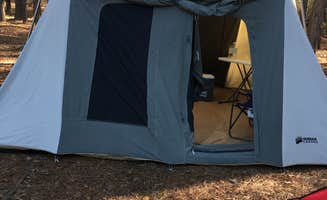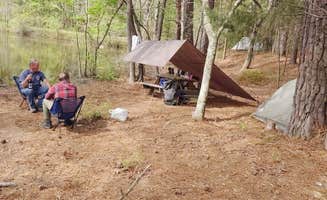Congaree National Park provides primitive tent camping near State Park, South Carolina, with sites that require varying degrees of hiking and preparation. Positioned within a floodplain ecosystem, campers must account for seasonal flooding potential, particularly after heavy rainfall. Summer temperatures regularly exceed 90°F with high humidity, making spring and fall the most comfortable seasons for tent camping at State Park.
What to do
Wildlife observation at dawn: Longleaf Campground offers excellent opportunities for wildlife viewing, especially in early morning. "We saw other wildlife around the campground too. A lizard during a walk during the day. Many frogs during the rain at night," reports Veronica S., who stayed at Longleaf Campground.
Explore ancient trees: The park features remarkable old-growth forests with towering specimens. "Pristine, but organized trails near the Consgree river and Swamp. Lots of wildlife and ancient trees on the trails," notes J Terrell M. about his experience camping near the park.
Firefly viewing in May-June: The synchronous fireflies are a major attraction during late spring. "The fireflies were very pretty and interesting," mentions Veronica S. May through early June typically offers the best viewing opportunities, with peak activity occurring approximately two weeks after initial sightings.
What campers like
Peaceful atmosphere: Many campers appreciate the quiet environment at Bluff Hike In Campground, which requires a one-mile hike to reach. The additional effort results in fewer neighbors and more solitude compared to more accessible campgrounds.
Spacious sites: Tent pads at Longleaf offer adequate room for setup despite natural terrain challenges. "Campsites are spacious and clean," reports Kim L., who appreciates the well-maintained grounds at Longleaf Campground.
Night sounds: The natural chorus of frogs creates a distinctive camping experience. "The campground is next to a pond that gets rather loud at night. I never knew frogs/toads could be so loud," shares kelly, highlighting the immersive natural soundscape that surrounds campers after dark.
What you should know
Insect preparation essential: Mosquitoes and deer flies can be intense, particularly in warmer months. "Definitely bring a wagon for packing your stuff in and prepare to be eaten alive by deer flies everywhere you go," warns Jacinda S. from Longleaf Campground. Bug nets, repellent, and protective clothing are necessities rather than options during summer.
Flooding risk: Low-lying areas can become waterlogged after rain. "The first night got a lot of rain and storms and several of the campers from sites farther back left saying they were flooded out," shares Veronica S., though she notes their tent pad "stayed fully drained" despite surrounding water.
Water planning required: No potable water exists at campgrounds. "I never did figure out where the spigot was at the visitor center, but I didn't ask anyone," notes a camper, highlighting the importance of bringing sufficient water or confirming visitor center water access before arrival.
Tips for camping with families
Choose sites closer to parking: For families with young children, select sites with minimal hiking distance. "Sites 1-3 are the easiest to get to. We were at site 7, it took about 250 steps from the parking lot to our site," explains kelly from Rocky Branch Hunt Camp, providing practical insight for families considering the walk-in requirement.
Bring transport assistance: A utility wagon helps move gear from parking to campsites. "It would be nice to have a second person or a wagon," advises Allissa F., who stayed at the site closest to the parking lot but recognized the value of transport assistance for longer stays.
Consider seasonal timing: May offers memorable experiences with fireflies while avoiding peak summer heat. "We camped here to see the synchronous fireflies, and loved our stay! The group site was plenty big enough for all of the children," shares Trina W., suggesting the spring season as ideal for family camping experiences.
Tips from RVers
Limited hookup options: Most camping near State Park is primitive tent camping. Blythewood Acres offers one of the few options with RV hookups in the vicinity. "Water, sewer, power and dump station on site! These sites are level and waiting for your RV," notes Ashley F., highlighting this rare full-service option near State Park.
Advanced planning required: RV sites are extremely limited in the immediate State Park area, requiring reservations well in advance, especially during spring and fall peak seasons when temperatures are most comfortable for tent camping at State Park.
Consider nearby alternatives: With only two RV sites at Blythewood Acres, travelers with larger vehicles often need to look toward Columbia for more accommodations, approximately 30-40 minutes from the main park areas.



